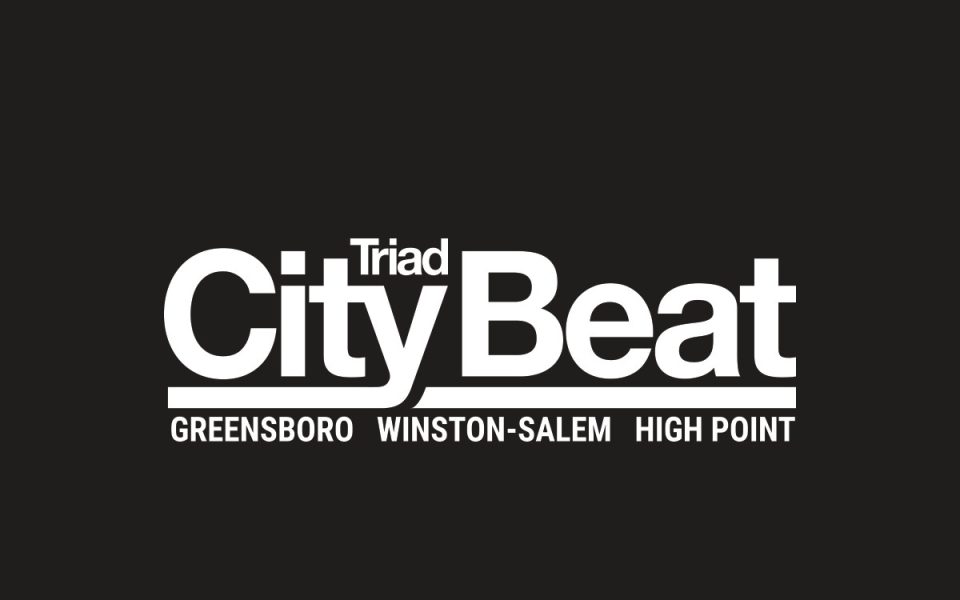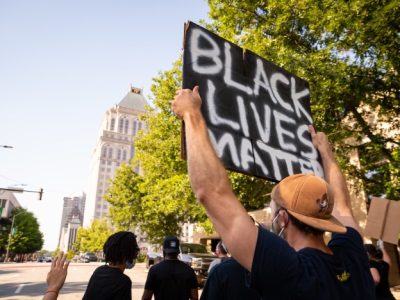 by Andrew Young
by Andrew Young
If you walk around my neighborhood you have some good views of the old Revolution Mill, once our economic engine when denim was king. Long ago thousands left farms to come to the city to work, tripling Greensboro’s population. The mill’s smokestack still stands with its name spelled in elegant red caps, R-E-V-O-L-U-T-I-O-N. But it’s surprising this powerful image is seldom used to promote us, because without the vast labor force to run it, there would have been no Greensboro. Even today the mill houses stand, still functioning as intended. “Honest architecture” one community advocate called them.
You can’t see the smokestack from Aycock neighborhood, built to connect downtown to the mill and named after our state’s notorious white supremacist former governor. But you’ve got a great view looking down Vine Street. From the scruffy urban woods that makes up the Audubon natural area you see the smokestack in the late afternoon light. The big letters face west. I can also see them framed between my neighbor’s toolshed and cornstalks.
My neighborhood, McAdoo Heights, overlooks the mill, smokestack and the low ground through which Buffalo Creek wends. It is bounded by Elm and Church streets and Cone Hospital. Cross Elm and you’re in Irving Park. Cross Church and you’re effectively on the east side of town. The 2013 Racial Dot Map is instructive. On crowded football nights we hear game sounds from Page and in the summer the thump of downtown fireworks. A while back a bear cub was spotted. I once rescued an enormous turtle whose habitat was disturbed by torrential June rains. Last fall we saw a family of deer scurry past.[pullquote]Being on the fringe of the white-black divide was convenient; it made it easy to dash from one side of town to the other. I began to see Greensboro in a different light.[/pullquote]
Michael Jordan dined here. Newt Gingrich came and promoted his book at the Carolina Coffee shop, operated by his daughter. After a few versions it was renamed Greensborough Coffee. Under the able stewardship of Luke and Tobey, a young couple, the counter’s tchotchkes disappeared in favor of decent bagels and muffins. Commuters would drop in and then be off quickly to work. But there were others like the church committee, the EMT crew, hospital doctors, Republican retirees eager to read the Wall Street Journal, and eventually more people who lived in the neighborhood, including dog walkers like myself. Luke and Tobey staged music events that spilled into the back courtyard. They started a community garden. Obama carried North Carolina. They made the coffeeshop a welcoming place for everyone and it seemed things couldn’t get better.
They didn’t. The collapsed economy stopped Irving Park guys going for haircuts because they’d lost jobs. Still Luke and Tobey kept the coffeeshop going. Prices rose as unemployment bit deeper. Then the unbelievable happened: People ditched their SUV gas hogs. As my game-design contracts became spottier I spent more time working with refugees and poor people who were struggling even before 2008. The coffeeshop became a center where I’d meet people to fill out food-stamp applications. Being on the fringe of the white-black divide was convenient; it made it easy to dash from one side of town to the other. I began to see Greensboro in a different light.
To believe that the name “Revolution” referred to commercial innovation or the impact factory life would have on farmers, turning them into compliant clock-punchers living in company cottages with running water, is partly true. But Southern culture is built on code words. Revolution Mill was built at the height of lynching, something you’d never guess from Sallie Walker Stockard’s astonishing 1902 account:
“Situated on a plain slightly inclined toward the sunrise, is Greensboro, Queen of Piedmont Carolina. Surrounded by beautiful, undulating fields covered with soft Japanese clover, buffalo grass and abundant wild flowers, she is called the ‘City of Flowers.’ Once this section was prairie, it is said, but there are now tall oaks, poplars and elms of such strength and size as to suggest forest primeval…. Her hotels are famous. Her people are kind, cultured and hospitable. Her health is perfect.”
In this reality distortion field, “Revolution” meant the Revolutionary War, a better time for white Southerners (Decoded: When slavery was kept intact and whites were allowed to exploit and kill African Americans). It also fit in nicely with their rebranding of the Civil War as Revolution No. 2, the noble defense of the first revolution. In 1898, Aycock and others succeeded in overturning Wilmington’s government and his name continues to adorn Greensboro buildings. In 1899, “Revolution” was code for a stupid, violent and defeated idea, but one that white Southerners would not let go. It called the city’s west side (the sign faces west) to remember what they fought for from 1776-1865, and how they should fight on. Today I live in a mill house, but Greensboro’s code no longer baffles me. As I recall the old coffeeshop (it closed a couple of years ago), I wonder why the need for coded speech persists and how much better Greensboro would be without it.
Andrew Young’s favorite coffee place is the welcoming Deep Roots Market.
Join the First Amendment Society, a membership that goes directly to funding TCB‘s newsroom.
We believe that reporting can save the world.
The TCB First Amendment Society recognizes the vital role of a free, unfettered press with a bundling of local experiences designed to build community, and unique engagements with our newsroom that will help you understand, and shape, local journalism’s critical role in uplifting the people in our cities.
All revenue goes directly into the newsroom as reporters’ salaries and freelance commissions.





Leave a Reply